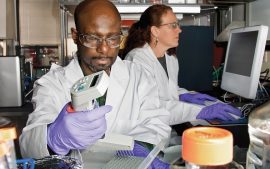It kills millions of people and is carried by a quarter of humans, yet there has been just a handful of new drugs in decades and the only vaccine is a century old.
Tuberculosis, a curable and preventable lung infection, killed more than 1.6 million people last year, almost as many as HIV/AIDS and malaria combined and is the world’s deadliest infectious disease.
But despite possessing the knowhow to treat it, and even how much it would cost to eradicate, global efforts to rid humankind of one of its oldest illnesses lag behind other public health drives.
“TB has been killing millions of people for thousands of years and it’s a slow-moving disease. You can get infected and never get sick, or not get sick for decades,” said Ann Ginsberg, senior technical adviser at IAVI, a non-profit that works on tuberculosis.
“You don’t see it. Even when you get it, you get cough, fever, some night sweats. It’s not spectacular.”
The World Health Organization says 10 million people developed tuberculosis in 2017 and global infection rates, while declining, remain stubbornly high.
But this year has seen several breakthroughs, including trials of a new vaccine and a pill that shows astonishing success against drug-resistant forms of the bug, which experts say are cause for optimism.
More than 3000 scientists, activists and disease survivors gathered this week in The Hague for an annual conference on lung health that was dominated by advances in the battle against tuberculosis.
Several countries, including South Africa and Belarus showed that a new drug, bedaquiline, was consistently successful in patients with drug-resistant tuberculosis in some cases curing 80%.
Adrian Thomas, vice president of global public health at Johnson & Johnson, which holds the patent on bedaquiline, said the drug could revolutionise how some TB is treated.
“It means you don’t have the cost of the injectables, you don’t have the administration, which has to be by a healthcare professional, and you don’t have the toxicity, but you get the advantages in terms of mortality,” he told AFP.
Previously, those suffering from multidrug-resistant TB would have to undergo an eight-month course of excruciating injections, often several times a day and with severe side effects, including hearing loss in around half of patients.
“At the end of that process they would often say that dying would be easier than actually taking the drugs,” said Thomas.
Ahead of a recommendation by the WHO that more multidrug-resistant patients should receive bedaquiline, this year Johnson & Johnson dropped its price to $400 per course of treatment.
For Sharonann Lynch, HIV and TB policy advisor at Doctors Without Borders, that’s still too high. Her organisation wants bedaquiline to cost $1 a day, half the current price.
“They say they are losing money but one third of the cost goes on funding to health system strengthening,” she said.
“Why in the world would sick people need to pay for health system strengthening? That should be the responsibility of governments.”
Thomas said that due to how it is funded and distributed, most people with access to bedaquiline who need it don’t pay for the treatment themselves.
Despite its deadliness, there has been just a single widely used vaccine against TB for nearly 100 years. But this too may be changing.
Last month drugs giant GlaxoSmithKline unveiled a study of a new vaccine that was effective in 54% of trial participants.
It comes with caveats the trial was only on people in three African countries who already had tuberculosis but weren’t yet sick from it and is in its early stage, but Ginsberg described it as a “turning point”.
Marie-Ange Demoitie, who leads the vaccine development for GSK, said the eventual aim would be to give it to everyone of a certain age in areas where TB is prevalent.
“There are several candidate vaccines at the moment but this is the first time we see a positive signal in a population of adult subjects,” she told AFP. “It’s really a breakthrough and is bringing a lot of hope to the TB vaccine field.”






